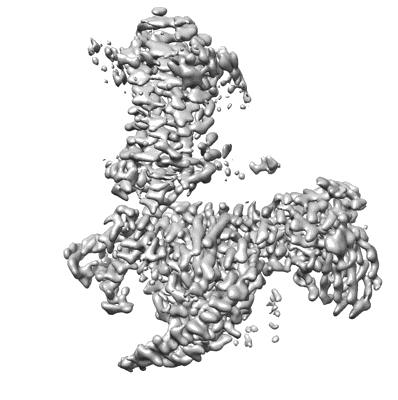EMD-36007
Cryo-EM structure of thehydroxycarboxylic acid receptor 2-Gi protein complex bound niacin
EMD-36007
Single-particle3.05 Å
 Deposition: 26/04/2023
Deposition: 26/04/2023Map released: 03/04/2024
Last modified: 03/04/2024
Sample Organism:
Homo sapiens
Sample: complex of hydroxycarboxylic acid receptor 2 with MK-6892
Fitted models: 8j6l (Avg. Q-score: 0.4)
Deposition Authors: Yuan Q, Zhu S, Duan J, Xu HE, Duan X
Sample: complex of hydroxycarboxylic acid receptor 2 with MK-6892
Fitted models: 8j6l (Avg. Q-score: 0.4)
Deposition Authors: Yuan Q, Zhu S, Duan J, Xu HE, Duan X
Molecular recognition of niacin and lipid-lowering drugs by the human hydroxycarboxylic acid receptor 2.
Zhu S,
Yuan Q,
Li X,
He X,
Shen S,
Wang D,
Li J,
Cheng X,
Duan X,
Xu HE,
Duan J
(2023) Cell Rep , 42 , 113406 - 113406
(2023) Cell Rep , 42 , 113406 - 113406
Abstract:
Niacin, an age-old lipid-lowering drug, acts through the hydroxycarboxylic acid receptor 2 (HCAR2), a G-protein-coupled receptor (GPCR). Yet, its use is hindered by side effects like skin flushing. To address this, specific HCAR2 agonists, like MK-6892 and GSK256073, with fewer adverse effects have been created. However, the activation mechanism of HCAR2 by niacin and these new agonists is not well understood. Here, we present three cryoelectron microscopy structures of Gi-coupled HCAR2 bound to niacin, MK-6892, and GSK256073. Our findings show that different ligands induce varying binding pockets in HCAR2, influenced by aromatic amino acid clusters (W91ECL1, H1614.59, W1885.38, H1895.39, and F1935.43) from receptors ECL1, TM4, and TM5. Additionally, conserved residues R1113.36 and Y2847.43, unique to the HCA receptor family, likely initiate activation signal propagation in HCAR2. This study provides insights into ligand recognition, receptor activation, and G protein coupling mediated by HCAR2, laying the groundwork for developing HCAR2-targeted drugs.
Niacin, an age-old lipid-lowering drug, acts through the hydroxycarboxylic acid receptor 2 (HCAR2), a G-protein-coupled receptor (GPCR). Yet, its use is hindered by side effects like skin flushing. To address this, specific HCAR2 agonists, like MK-6892 and GSK256073, with fewer adverse effects have been created. However, the activation mechanism of HCAR2 by niacin and these new agonists is not well understood. Here, we present three cryoelectron microscopy structures of Gi-coupled HCAR2 bound to niacin, MK-6892, and GSK256073. Our findings show that different ligands induce varying binding pockets in HCAR2, influenced by aromatic amino acid clusters (W91ECL1, H1614.59, W1885.38, H1895.39, and F1935.43) from receptors ECL1, TM4, and TM5. Additionally, conserved residues R1113.36 and Y2847.43, unique to the HCA receptor family, likely initiate activation signal propagation in HCAR2. This study provides insights into ligand recognition, receptor activation, and G protein coupling mediated by HCAR2, laying the groundwork for developing HCAR2-targeted drugs.
